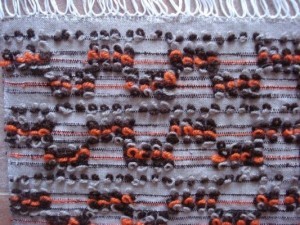
The art of carpet emerges in the places where Turks live and spread from these regions to the world. The pioneering role of the nomadic Turks in Central Asia in carpet and rug weaving is indisputable. From the times of Anatolian Seljuks, Beyliks and Ottomans, many examples of this art that has developed for centuries reach the present day. The most basic component of Turkish carpets is the Anatolian Seljuk carpets. The ones produced in Konya and woven in Gördes knot technique follow a continuous pattern since the 13th century. Similar examples are found in Beyşehir, Fustat (Old Cairo).
Geometric motifs dominated the Seljuks’ carpets. While the floral ornament was stylized and made close to geometry, a writing resembling kufi was used as a decorative element. The most commonly used motifs are arrows, stars, octagons, hooks, baklava, swastika (gambled cross), S, U letters; red, blue, yellow and green are the most commonly used colors. As of the 14th century, animal figures started being used in carpets. Birds, quadrupeds, stylized animals, dragons, double-headed eagles are the most common of these animal figures.
In the late 15th and 16th centuries, carpets with geometric motifs were seen in European paintings. Nowadays, these carpets, which are defined as examples of the early Ottoman period, are wrongly called "Holbein Carpets". The Seljuks tradition continues to be used in Holbein Carpets, which are divided into four types, in Kufi writing style and abstract floral motifs.
With the 15th century, there were also styles and technical varieties that vary according to the region. Competition among the beyliks helped increase the quality of carpet production. Thanks to the orders of the palace in the Ottoman period, the superior quality carpets were woven and carpet production centers such as Bergama, Ladik, Kula, Karaman, Polonez were developed. The classical period of the art of carpet was the 16th and 17th centuries. While the tradition of Seljuk geometric pattern continued, medallion carpets with rich floral decoration began to be produced. In Uşak carpets known as medallion or star, medallions were placed on the ground in a theme of infinity. Another important group in the same period was the classical Ottoman carpets called "Palace Carpets". They were produced according to various needs for the palace and they attracted attention with their naturalistic flower motifs. These motifs could be processed more easily by using Iranian knot instead of Gordes knot. Depending on the designs sent from Istanbul, the palace carpets produced in Cairo were woven with a thin wool that was similar to the silk. It is known that the masters were brought to the capital with an edict and they probably wove carpets in Bursa.
Today, in many parts of Anatolia, carpet weaving continues in old carpet centers such as Konya, Kayseri, Sivas, Isparta, Uşak, Bergama, Kula, Gördes, Milas, Çanakkale, Balıkesir. As is the case in the past, most of the performers of carpet art today are women.
Kilim generally refers to the napless rugs outside of the carpets that have plain woven. “Bez ayağı” weaving is the basic weaving technique. The rugs, whose front face are the same with the back face, are in the shape of weft threads since its wefts are more than its warps. They are woven as smooth, striped or with motifs. The materials used in rugs are usually wool, sometimes hair or cotton yarn. The rugs are thinner than carpets, thicker than clots but do not require a special tool for weaving; they can be woven on carpet benches.
Although it is known that the history of rugs and similar textiles goes back to late history, it is believed that the tradition of rug weaving has moved from Central Asia to Anatolia. Tents, pillows, saddlebags, sacks, passenger covers were usually made with this weaving technique. The floors and walls of the tents were covered with rugs.
Other sorts of rugs that are woven in rug technique are sumak, cicim and zilidir. Sumak is formed by wrapping colored motif yarns around warps in addition to ground weaving. After each row of sumak, ground weft thread can be removed or the whole rug can only be woven with sumac yarns. The cicim is a technique of creating patterns by skipping yarns in the form that it appears as if it was processed by needles on the ground with other colorful yarns, while the ground weave continues. The tips of the motif yarns are left behind. While continuing to weave, the rear yarns are brought forward to form a motif and this process is repeated. Embroidered kilims composed of small pieces are also called cicim. Zili differs from these rugs types with its three yarn systems. Colorful weft yarns, which make jumps on the surface in such a way as to create patterns on the ground, intersect with the warp at the same point and diagonal lines are formed on the pattern.
Weaving now continues in the main centers of Manisa, Niğde, Konya, Afyon, Sivas, Kayseri, Hakkâri. Sometimes they are known by the names of cities where they are woven, and sometimes by the tribes (Yoruk, Beritan, etc.).




